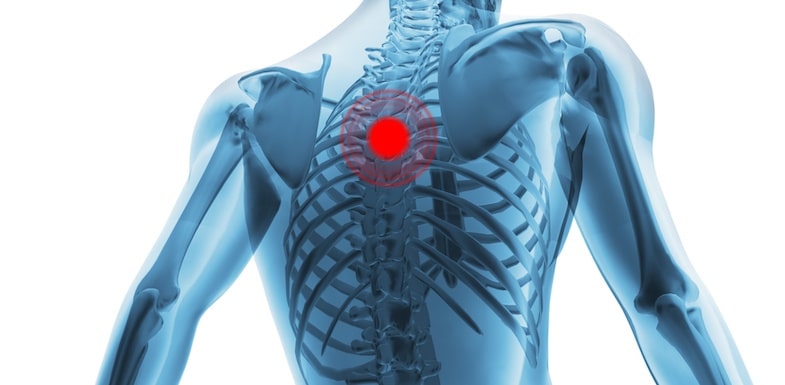Low back pain affects approximately 80% of the general population at least sometime during their lifetime. It is also the fifth leading cause of physician visits, as well as the leading cause of work-related disability. One of the most challenging aspects of treating back pain is getting a proper diagnosis from the start. For so many people, what seems like a muscle strain might actually be an underlying chronic condition. Even a minor ache can indicate serious injury. Using discography can help diagnose the cause of back pain for more effective treatment. Here’s what you need to know.
Discography is a diagnostic tool that can help determine whether certain discs of the spine are the source of your neck or back pain. Understanding the anatomy and function of the spine is the key in evaluating a person with back pain and learning what discography is.
Your bony spine is positioned so that 33 individual vertebrae provide a flexible support structure while also protecting the spinal cord. Separating each individual vertebra are discs that act as cushions to minimize the impact that the spinal column receives. These intervertebral discs are designed to be soft and provide support. Stabilizing this entire structure are ligaments and tendons that connect the facet joints to each other. These joints sit where the vertebrae meet each other.
Each of these structures provide strength and stability to the spine, but they are also prone to damage. Certain conditions that can lead to chronic back or neck pain include the following:
In addition, disc disease is one of the most common causes of chronic back pain and accounts for approximately 10% of all lower back pain complaints. Disc disease may be acute after an injury, such as when herniation results from trauma. More commonly, though, disc disease (e.g. degenerative disc disease) is chronic in nature.
Sometimes the individual cause of chronic back pain is difficult to diagnose. Discography can diagnose the cause of back and neck pain, especially when non-invasive imaging, such as magnetic resonance imaging (MRI), does not reveal abnormalities consistent with the pain symptoms.
Discography is an option for patients who have disabling low back pain, neck pain, and radiating arm or leg pain when other conservative diagnostic methods and treatments have failed.

MRIs, CT scans, and X-rays are often the first diagnostic tools for lower back pain. MRIs and CT scans look for possible soft tissue damage. X-rays examine the bones closely for deterioration or damage. Although MRIs and CT scans are good methods for showing disc abnormalities, they often do not show direct causes of pain.
But can discography help diagnose the cause of pain when MRIs, CT scans, and X-rays show no structural issues?
A review of studies published in the journal Pain Physician indicated that discography does accurately diagnose the cause of low back pain. Another study in 2007 concluded that the use of discography is more effective than MRI for detecting intervertebral disc ruptures as well as other conditions.
This is good news for patients who are experiencing high pain levels but have not been able to get any answers from a traditional MRI. MRI and CT scans may or may not show anatomical dysfunctions, but discography is able to pinpoint the exact locations producing the pain.
This is a crucial distinction between the diagnostic tools. Sometimes visually abnormal discs found on MRI or CT scan can be completely asymptomatic and do not cause pain. Even minimally-affected discs can produce severe pain but may not be treated accordingly based on imaging alone. Since discography is considered a minimally-invasive procedure, it is performed when your doctor believes that a disc may be the cause of your pain but cannot confirm it with MRI.
Typically, patients who undergo discography have unsuccessfully tried other methods for pain relief including medication, physical therapy, and activity modification. Although these strategies work for a wide range of back pain syndromes, sometimes a more accurate tool is needed for treatment. Discography can be that tool.
Before the discography procedure begins, your doctor answer any of your questions and make sure you are comfortable. In this outpatient procedure, your skin above the targeted disc will be cleaned, and a local anesthetic will be injected to numb the area.
Using fluoroscopy, your doctor will inset a larger needle through the anesthetized skin and position it near the outer layer of the disc. A contrast solution is injected into the disc, and your response to the injection is observed at different locations.
If you experience pain that is similar to your chronic pain condition when the solution is injected, then it is possible that your doctor has located the source of your pain.
This process is typically repeated at two additional discs. The whole procedure generally takes less than hour. Once the disc has been located, you may also have a CT exam directly after the discogram to get the most accurate location of your pain.
Typically, discography is considered low risk, but as with all medications and interventions, there is always a risk of complications. Although uncommon, discitis can occur. Discitis is an infection of the disc and presents as pain. Other risks are bleeding, hematoma, headache, and increased pain.
Discography is a minimally-invasive procedure with very little recovery time. Rest on the day of your procedure and gradually begin to add activity back in the following days.
The best part of your recovery is that you may actually have a better idea of the source of your back pain! This means that you and your pain physician can devise a treatment plan to work towards a better quality of life, with less pain.
If you have any questions or are simply looking for more information please contact us and our friendly team will be happy to answer your questions and help in any way we can.
